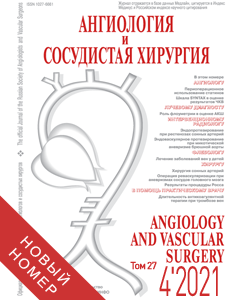Journal «Angiology and Vascular Surgery» •
2014 • VOLUME 20 • №2
Role of compression bandage with elevated level of pressure in decreasing incidence of venous thrombosis in high-risk patients
Barinov V.E.1, Lobastov K.V.1, Tsaplin S.N.2, Schastlivtsev I.V.1, Boyarintsev V.V.2, Laberko L.A.1
1) Chair of General Surgery and Radiodiagnosis of the Therapeutic Department, Russian National Research Medical University named after N.I. Pirogov,
2) Clinical Hospital No1 of the Administration of the RF President’s Affairs, Moscow, Russia
The study was aimed at assessing efficacy and safety of using graduated compression bandage with the level of pressure in the area of the middle ankle amounting to 20-40 mm Hg as compared to the conventional profile (10-20 mm Hg in the ankle area) in the composition of comprehensive prevention of postoperative venous thromboembolic complications (VTEC) in patients of a high-risk group. For this purpose we carried out a prospective randomized clinical study including a total of 100 surgical patients (general surgery, neurosurgery) from a group of high risk for the development of VTEC with the presence of 3 and more conditions predisposing to venous thrombosis. All patients were subdivided into two subgroups 50 patients each. Patients in both groups received anticoagulants in standard preventive doses from the first day after surgery or in the remote period. The Study group patients were treated by applying on the ankle a bandage of medium distensibility with the target pressure in the ankle area of 20-40 mm Hg measured by means of a portable manometer. The control group patients were treated by a similar bandage applied onto the ankle and femur with a pressure of 10-20 mm Hg. In all cases a special lining material was placed under the bandage. With the purpose of active screening of postoperative VTECs, prior to the beginning of the study and then each 3–5 days we performed ultrasound angioscanning and in case thrombosis was revealed we performed static perfusion scintigraphy of the lungs and/or echocardiography for verification of pulmonary embolism. The patients who died were subjected to post-mortem examination. We also assessed the frequency of correcting the bandage on the femur and crus.
Results. The incidence rate of postoperative venous thrombosis in the Study Group amounted to 16.0% (95% CI: 5.8-26.2%) and in the Control Group 36.0% (95% CI: 22.7-49.3%, p=0.039), with no significant differences in the incidence of proximal thrombosis or pulmonary embolism revealed. Maximal reduction of the development of venous thrombosis was revealed in patients with lower-limb paralysis amounting to 69.5%. The frequency of the development of cutaneous lesions under the bandage did not differ significantly between the subgroups, being 8% and 12%, respectively. The total number of corrections of the compression in the Control Group was significantly higher, amounting to 0.64±0.23 time a day versus 0.32±0.05 t/d (p<0.0001). Conclusions. The use of an elevated compression profile makes it possible to decrease the incidence of postoperative VTECs, especially in patients with palsy, not increasing the rate of cutaneous lesions under the bandages. Femoral compression provides no additional reduction of the incidence of thrombosis but creates an additional necessity of correcting the bandages.
KEY WORDS: venous thrombosis, pulmonary embolism, prevention, elastic compression, high risk.
P. 104
ARCHIVES MAGAZINE
2021 (Vol.27)
2020 (Vol.26)
2019 (Vol.25)
2018 (Vol.24)
2017 (Vol.23)
2016 (Vol.22)
2015 (Vol.21)
2014 (Vol.20)
2013 (Vol.19)
2012 (Vol.18)
2011 (Vol.17)
2010 (Vol.16)
2009 (Vol.15)
2008 (Vol.14)
2007 (Vol.13)
2006 (Vol.12)
2005 (Vol.11)
2004 (Vol.10)
2001 (Vol.7)
2000 (Vol.6)
1999 (Vol.5)
1998 (Vol.4)
1997 (Vol.3)


